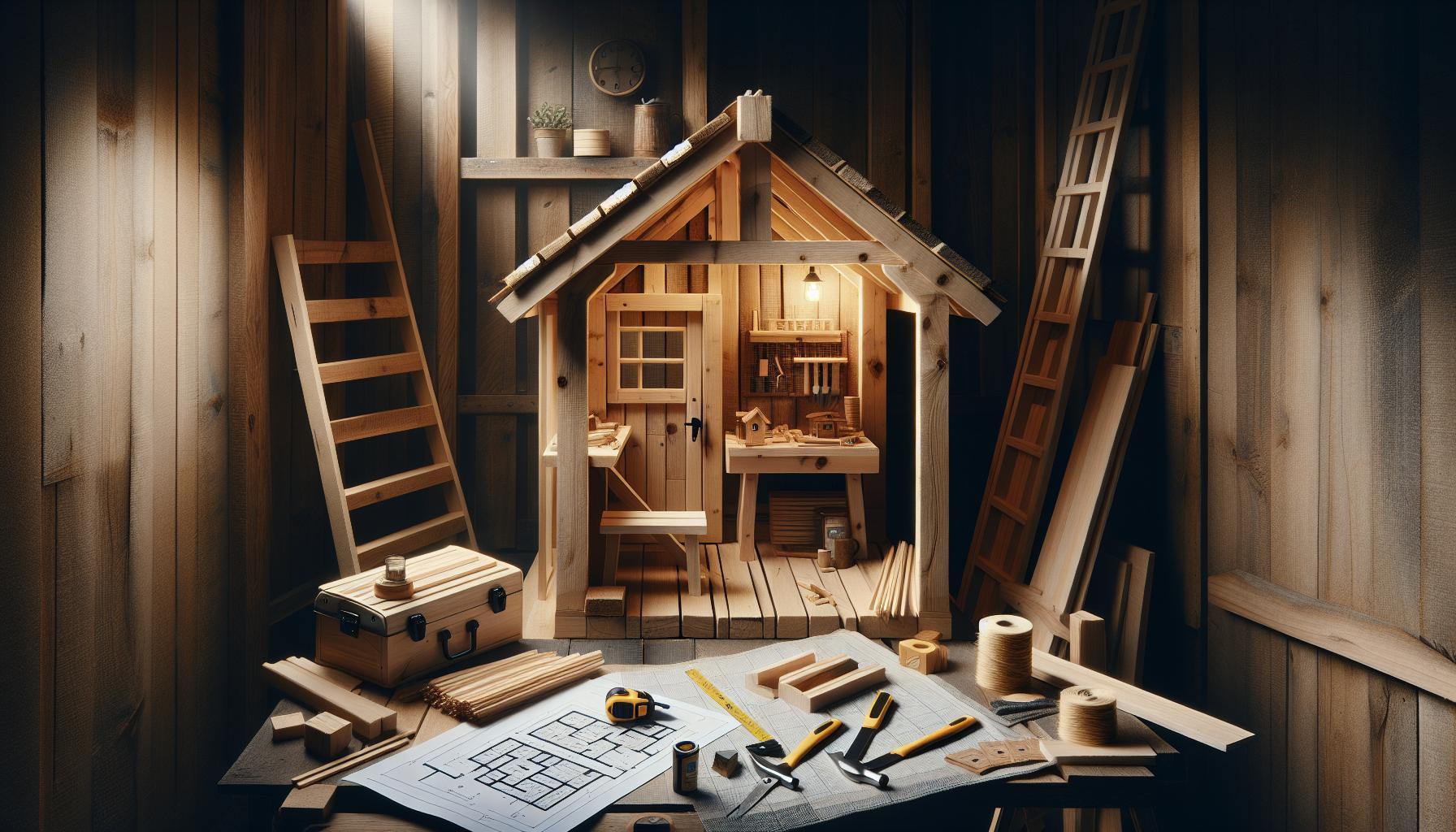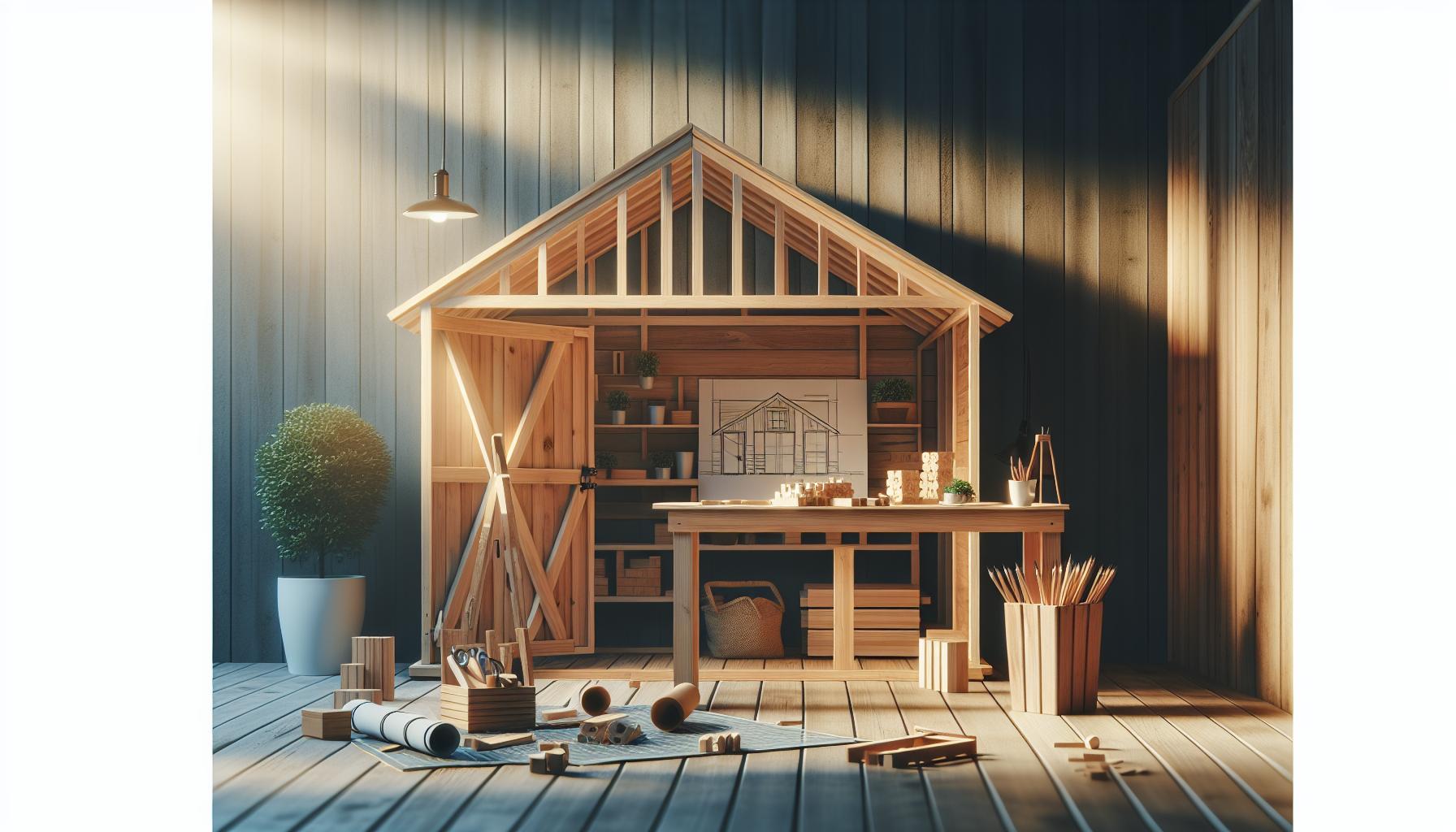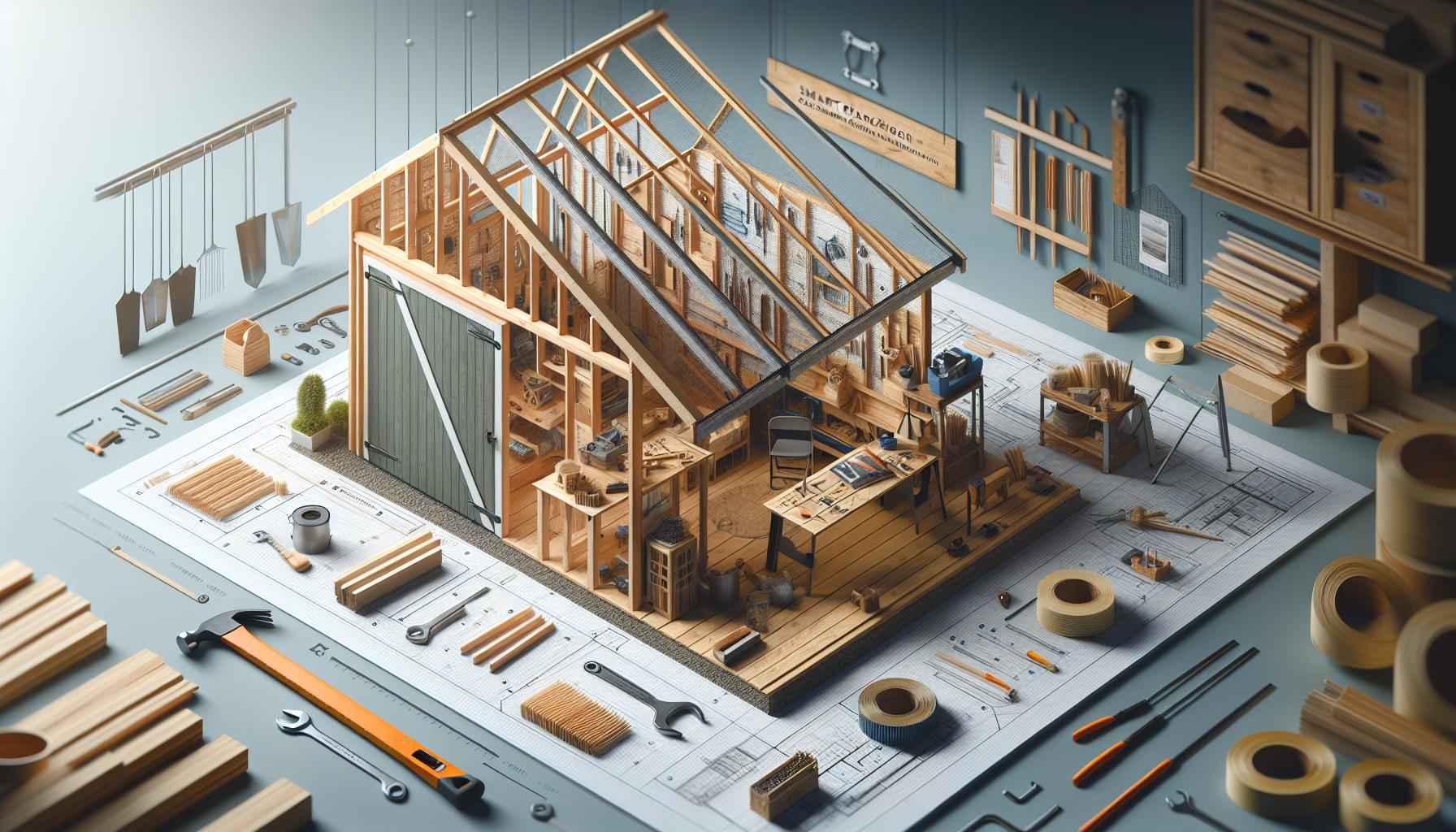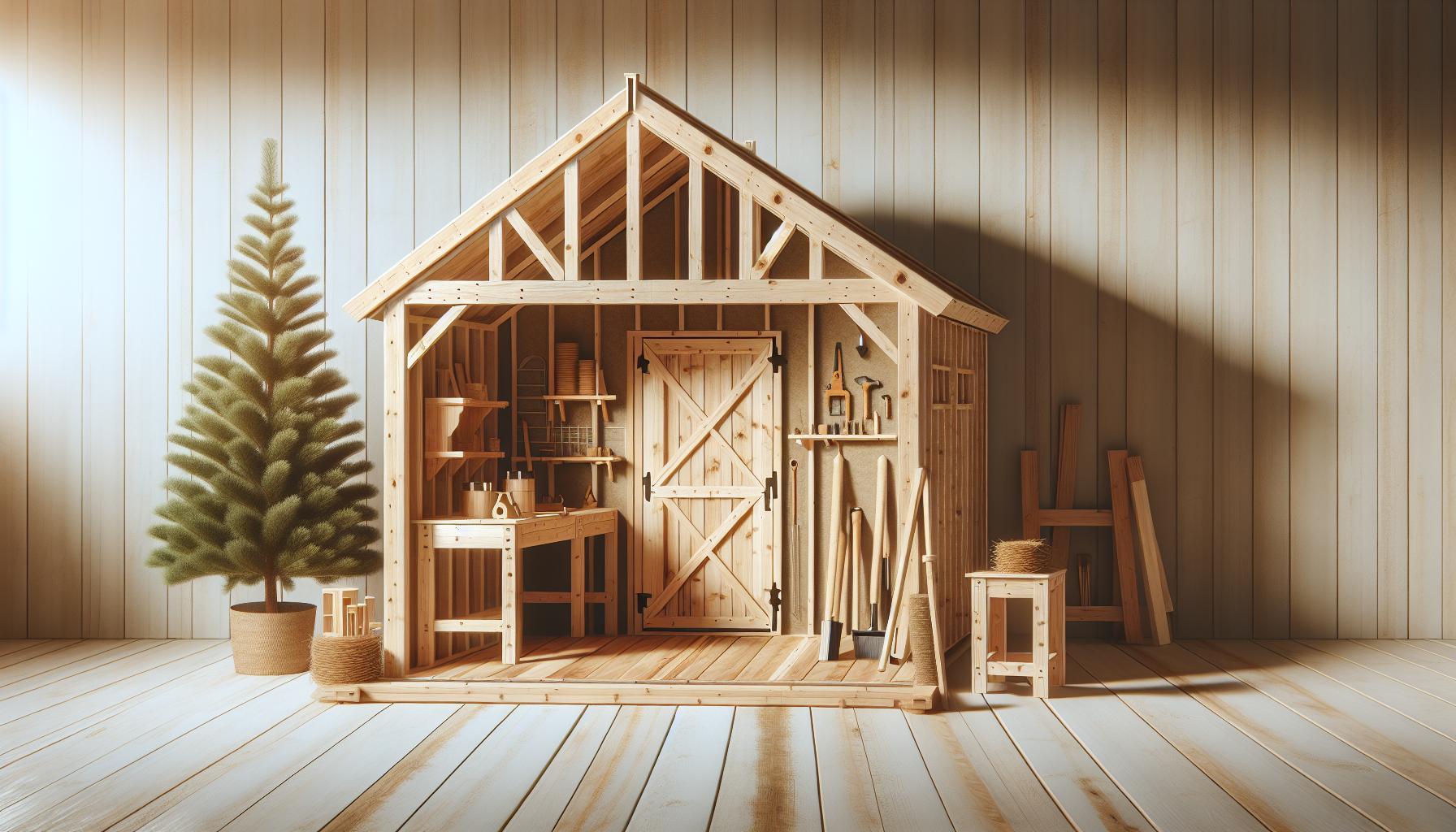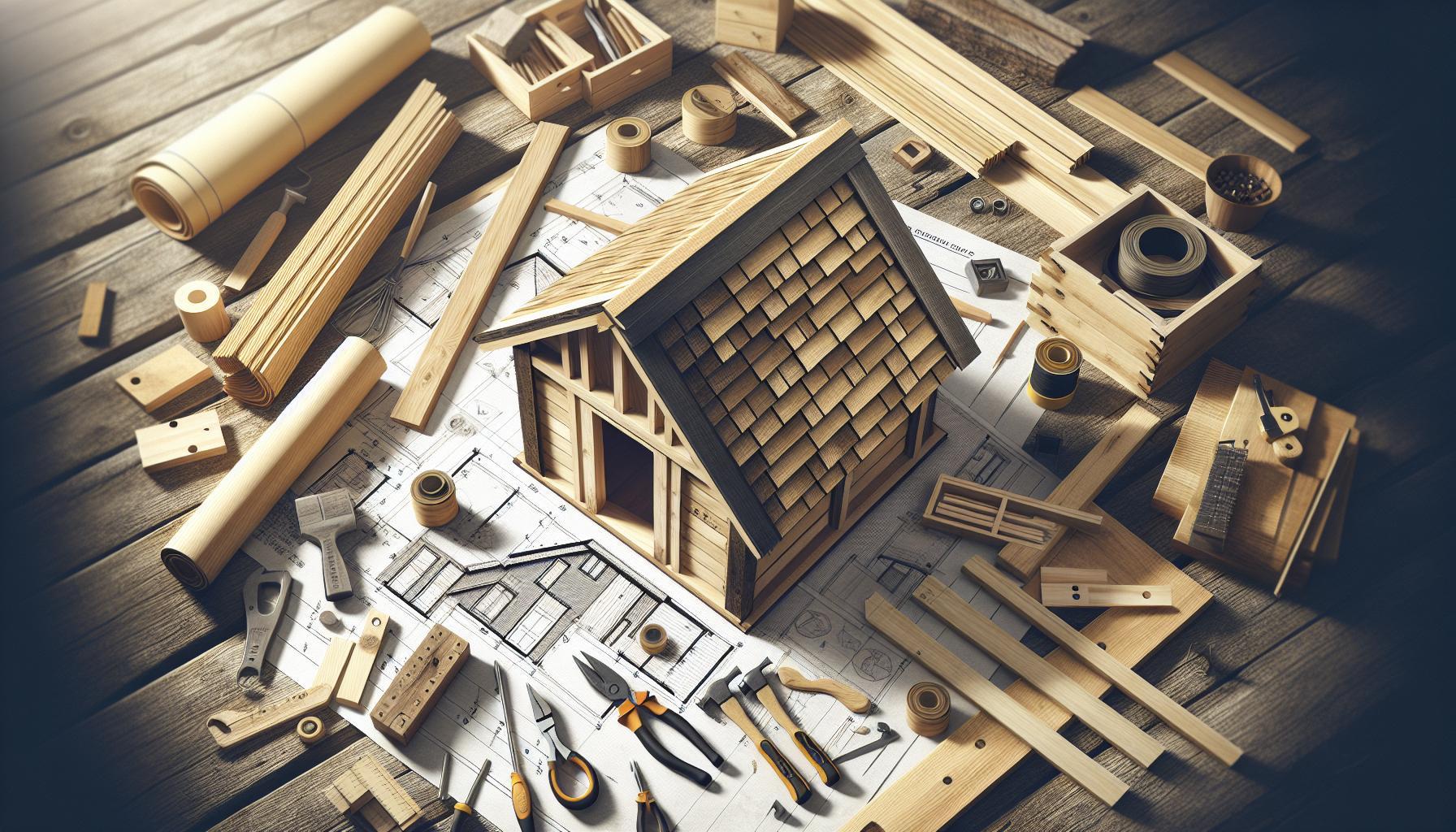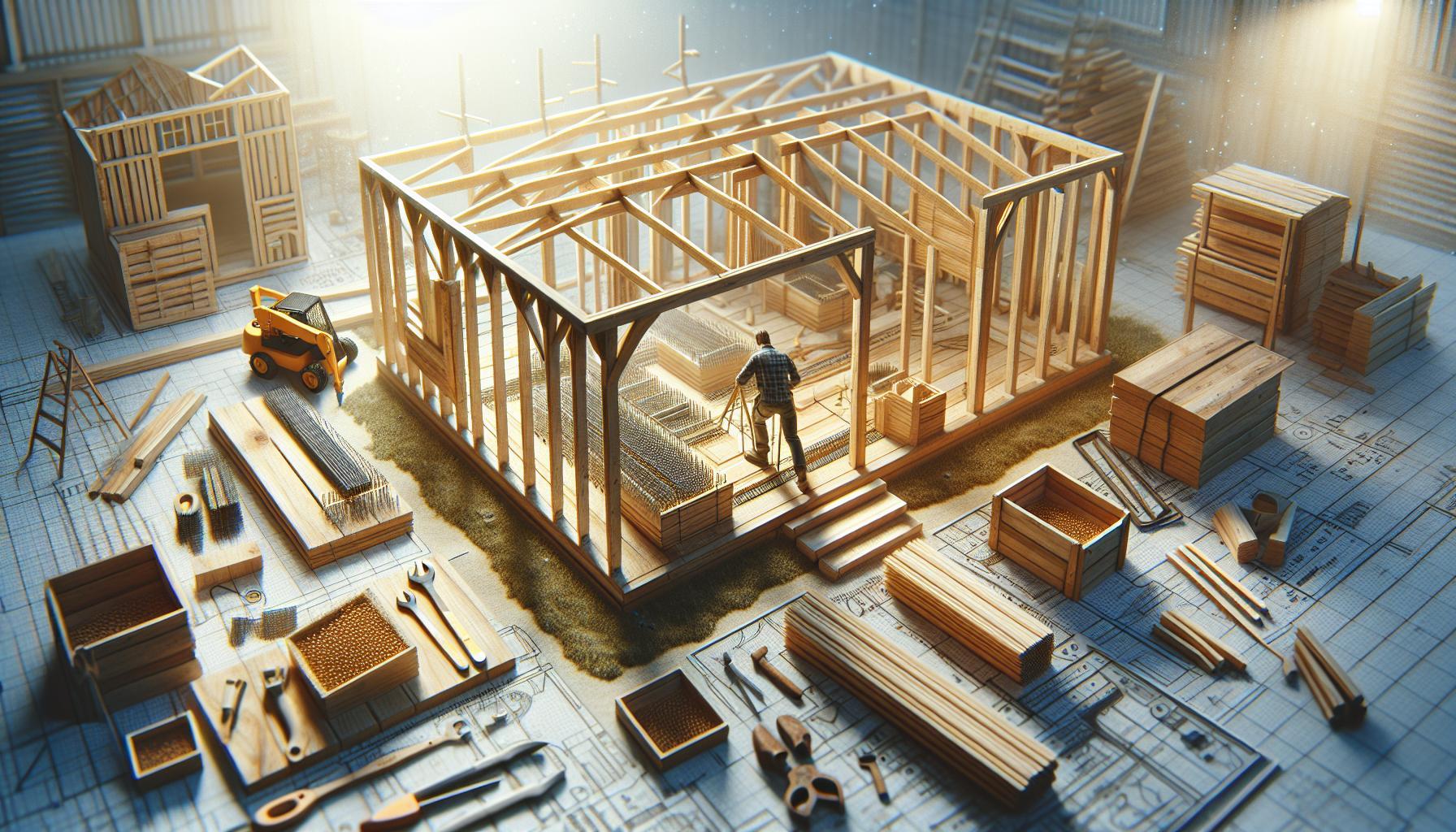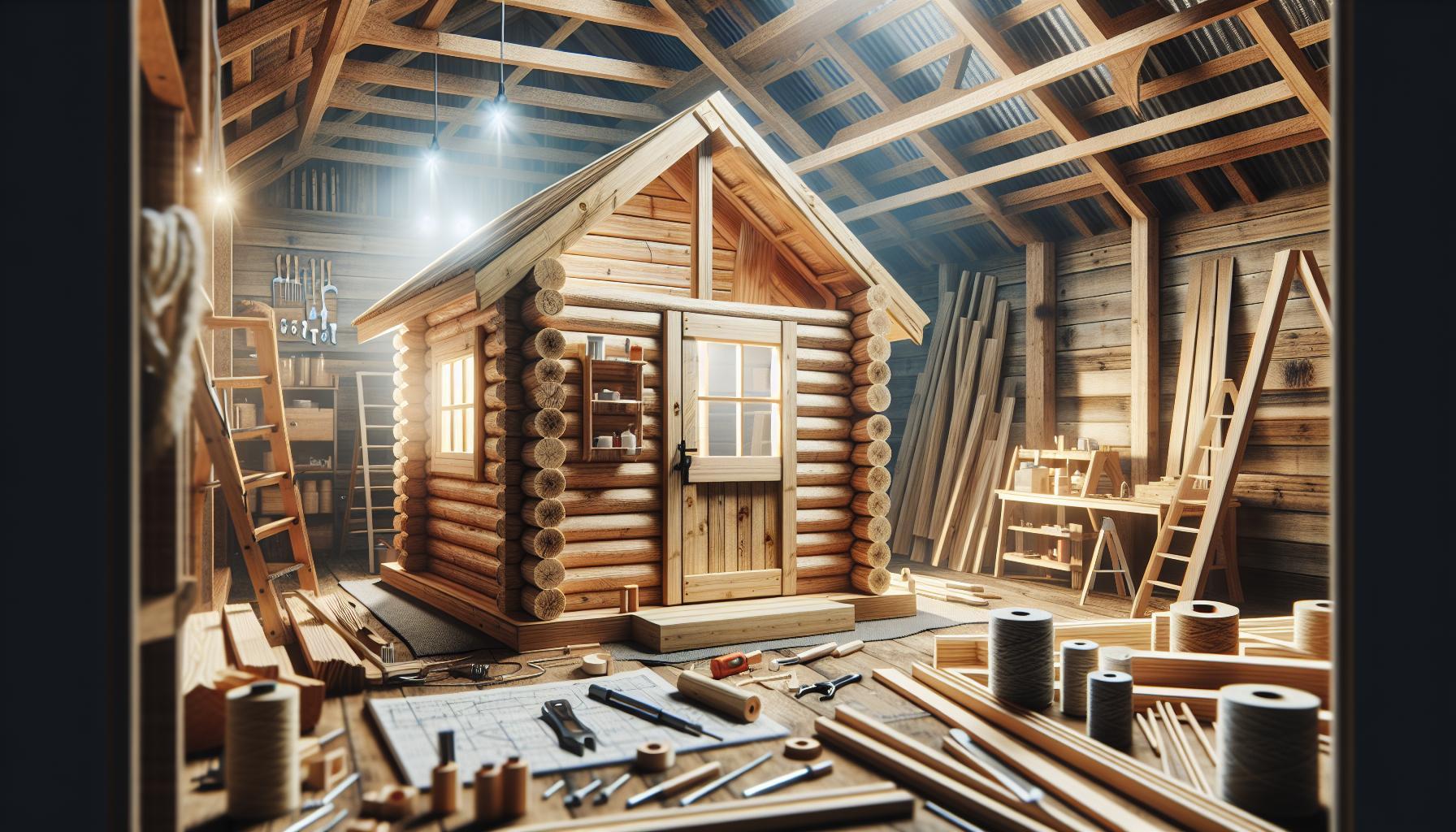Struggling with clutter in your outdoor space? Designing a small shed can be the perfect solution for maximizing tiny areas while providing essential storage adn functionality. In this guide, we’ll explore clever designs and key tips to help you create a stylish and practical haven for your tools and outdoor essentials.
Understanding the Basics: Essential Tools and Materials for Your Small Shed Project
Creating a small shed can be an exciting venture, offering a unique space for storage, hobbies, or even a cozy retreat.However, before diving into the construction phase, it’s crucial to equip yourself with the right tools and materials. Having the essential supplies not only boosts efficiency during your project but also ensures the result is sturdy, functional, and aesthetically pleasing.
To successfully embark on your small shed project, start by gathering the following essential tools:
Essential Tools for Construction
- Measuring Tape: Accurate measurements are critical to fit your design within the limited space.
- Level: Ensure your shed is built on a level base to prevent future issues with stability.
- Hammer or Nail Gun: For driving nails into wood,a nail gun can speed up your process considerably.
- Saw: A circular saw is typically best for cutting larger sheets of plywood and lumber.
- Drill: An electric drill makes installing screws and creating holes easier and more efficient.
- Safety Gear: Don’t forget gloves, goggles, and a dust mask to keep you safe while working.
Next, consider the materials that will form the backbone of your shed. Selecting high-quality materials not only enhances durability but also reduces maintainance needs down the line. Key materials to consider include:
choosing the Right Materials
| Material | Purpose | Recommended Quality |
|---|---|---|
| Pressure-Treated Lumber | Framing and support | Rot-resistant,typically rated for ground contact |
| Plywood | walls and roofing | Exterior-grade for moisture resistance |
| Metal roofing | Weather protection | Galvanized or aluminum for durability |
| Insulation | Temperature control | Fiberglass or foam boards |
| Paint or Stain | Finishing touches | Exterior-grade for weather resistance |
By ensuring you have the right tools and quality materials,you set a strong foundation for your shed project. This planning not only streamlines the building process but also maximizes the potential of utilizing tiny spaces effectively with clever designs. Whether you’re creating a small workshop or a storage haven, your newly constructed shed will be a testament to your planning and craftsmanship.
Designing for Efficiency: Clever Layout Ideas to Maximize space
Creating an efficient layout in a small shed can transform an often overlooked space into a well-organized haven for your tools, gardening supplies, or hobbies. The aim is to make the most of every square foot while maintaining a functional and inviting atmosphere. By employing clever design strategies, you can enhance usability, accessibility, and overall enjoyment of your tiny shed.
Utilize Vertical Space
One of the most effective ways to maximize limited floor space is by thinking vertically. Installing shelves or pegboards can free up valuable ground space while keeping your items organized and easily accessible. Consider these ideas for your vertical storage solutions:
- Shelves: Build sturdy shelves up to the ceiling. Use labeled bins or clear containers to categorize items, making it easier to locate what you need.
- Pegs and Hooks: Utilize the walls by installing pegs or hooks for tools, hoses, or gardening equipment. This not only declutters your floor but also displays your tools attractively.
- Hanging Planters: If you’re a garden enthusiast, incorporate hanging planters to grow herbs or small plants. This adds a touch of greenery while saving space on your work surfaces.
Foldable and Multi-Functional Furniture
Choosing furniture that can adapt to different needs is key in a compact shed. For instance, consider employing foldable tables and chairs that can be tucked away when not in use. Here are some ideas you might find useful:
- Foldable Workbench: Opt for a workbench that can be collapsed against the wall when not in use to create extra room for movement.
- Convertible Seating: Use benches with storage compartments or stools that can be stacked away to minimize visual clutter.
integrate Smart Storage Solutions
Integrated storage solutions can help you take advantage of every nook and cranny. By incorporating hidden compartments or cleverly designed furniture, you can store more without sacrificing style. Consider these options:
- Under-Bench Storage: Use the space beneath benches or tables to stow away tools or gardening supplies.
- Wall-mounted Cabinets: These can keep frequently used items off surfaces while still being within reach.
Incorporating these ideas into your shed design can greatly optimize the available space.By focusing on clever layouts that prioritize efficiency and association, you’ll create a functional workspace or storage area that feels larger than it really is, allowing you to embark on your projects with ease and enthusiasm. Remember, maximizing your tiny shed with accomplished design elements will enhance both its aesthetics and utility, making it a cherished part of your outdoor space.
Step-by-step Guide: Building Your Shed from the Ground Up
Building a shed can be an incredibly rewarding project, offering invaluable extra space for storage, gardening tools, or even a cozy workshop. Whether you find yourself muddling through a small backyard or simply want a designated area to store your outdoor equipment, mastering the skills of small shed construction can optimize your space with clever designs that work for your lifestyle. Here’s how to get started on your shed-building journey.
Planning Your Shed Design
Before diving into construction, thorough planning is essential. Consider your primary use for the shed and the materials compatible with your budget and aesthetic. Visualize the size and shape you want to achieve by sketching initial ideas or using design software.
- Define the Purpose: Will the shed serve as a garden tool storage, a workshop, or perhaps a play area for kids?
- Dimensions: Measure the available space and decide on the dimensions that fit. Remember to leave some walking space around it.
- Materials: Choose materials that suit the climate in your area, such as treated wood or metal, which are both durable and weather-resistant.
Gathering Tools and Materials
A successful build depends on having the right tools and materials on hand. Here’s a basic checklist to ensure you’re fully equipped:
| Tools | Materials |
|---|---|
| Measuring tape | Plywood or shingles for roofing |
| Level | 2×4 lumber for framing |
| power drill | nails or screws |
| saw (hand or power) | Doors and windows (if applicable) |
| Screwdriver | Paint or stain for finishing |
Establishing a Solid Foundation
A well-constructed shed starts with a strong foundation. Depending on your location and the intended use,you can choose between a concrete slab,treated wood,or gravel base. Here’s how to lay an effective foundation:
- Clear the Area: Remove any debris, vegetation, and grass from your designated area.
- Level the Ground: Use a level and a shovel to ensure the surface is even.
- Choose Your Foundation Type: For concrete, dig a trench, mix the concrete, and pour it into the form. For a wood foundation, lay treated lumber in a square, then fill it with gravel for drainage.
Once the foundation is set, it will be time to frame the walls, install the roof, and finally add any additional features like windows or doors. Each of these steps is crucial in ensuring your small shed maximizes functionality and adheres to smart design principles. By following this step-by-step guide, building your shed from the ground up will be not only manageable but also enjoyable.
Choosing the Right Location: Site Selection Tips for Your Shed
Selecting the right location for your shed is a pivotal first step in the process of maximizing small spaces and ensuring functional design. According to gardening and outdoor experts,a well-placed shed can enhance your backyard’s aesthetic while serving as a multipurpose space for storage,hobbies,or gardening.The challenge lies in optimizing your choice to align with both practical and creative needs.
Factors to Consider
When pondering the perfect spot for your shed, several critical factors come into play. Here’s a checklist to guide your decision:
- Accessibility: Choose a location that is easily reachable, not only for entering and using the shed but also for transporting materials like tools and gardening supplies.
- Sunlight Exposure: Depending on the shed’s intended use, consider how much sunlight it will receive. If you’re planning a potting shed, ample sunlight is beneficial, while tools and equipment benefit from shading.
- Level Ground: Ensure the ground is flat and stable to prevent water pooling, which can lead to structural damage over time.
- Distance from Trees: While trees provide shade, they can also drop leaves and sap, which complicates maintenance. Ensure your shed is situated far enough to avoid debris accumulation.
- Zoning Regulations: Always check local ordinances to understand any restrictions related to property lines and zoning to avoid future complications.
Environmental Considerations
Your surroundings plays a meaningful role in determining where your shed should go. Take a moment to assess factors such as soil type, drainage patterns, and nearby vegetation. For optimal placement, consider the following:
– Soil Type: Sandy soil drains quickly, whereas clay soil retains moisture. Choose a location that allows for proper drainage to extend the life of your shed.
– Natural Windbreaks: If wind is a concern, positioning your shed near existing fences or shrubbery can help shield it from strong gusts.
A real-World Example
Imagine you have a small urban backyard compacted between two neighboring properties. By sketching a diagram of your yard layout,you realize that the side closest to your home,although limited in space,gets a significant amount of morning sunlight while remaining sheltered from harsh afternoon winds. This strategic positioning not only maximizes the available space but also creates an inviting area for a tiny workspace or storage.
| Factor | Optimal Choice | Reason |
|---|---|---|
| Accessibility | Near a main path | Easy access for transport and working |
| Sunlight | Partial sunlight for tools, full sunlight for plants | Ensures a good environment for use |
| Wind Protection | Near natural barriers | Minimizes damage from strong winds |
| Elevation | higher ground | Prevent water pooling |
By thoughtfully considering these aspects, your shed won’t just occupy space; it will enhance it—a crucial concept when learning how to build small sheds that are indeed functional and aesthetically pleasing. The right location will lay the groundwork for a successful build, ultimately enabling you to maximize tiny spaces with clever designs.
Smart Storage Solutions: Organizing your Shed for Maximum Functionality
Organizing a shed effectively can transform it from a cluttered catch-all to a thoughtfully arranged space that enhances your gardening and DIY projects. As you embark on your journey of how to maximize tiny spaces with clever designs, it’s essential to implement smart storage solutions that not only optimize function but also create an appealing environment. By utilizing vertical space and multifunctional furniture, you can ensure every inch of your shed serves a purpose.
Utilizing Vertical Space
One of the most efficient ways to make the most of a small shed is to think vertically. Installing shelves, pegboards, and wall-mounted storage can dramatically increase your shed’s capacity without sacrificing floor space. Consider the following storage options:
- Wall Shelves: They allow for easy access to tools and supplies while freeing up valuable ground space.
- Pallet Racks: Upcycled pallets make excellent vertical storage for larger items like bags of soil or seasonal tools.
- Pegboards: Customizable and versatile, pegboards can hold everything from garden shears to ropes, keeping them organized and visible.
Multi-functional Furniture
Incorporating multi-functional furniture can also maximize storage. Look for pieces that do double duty, such as benches that open for storage or foldable tables that can be tucked away when not in use. This approach not only saves space but also reduces clutter:
| Item | Functionality | Benefits |
|---|---|---|
| Storage Bench | Sitting + Storage | Provides seating while hiding tools and supplies. |
| Foldable Workbench | Work Space + Storage | Offers a workspace when needed and folds away to save space. |
| Rolling Carts | Mobile Tool Storage | Can be moved to wherever you need it and tucked away when not in use. |
seasonal Organization
Taking into account seasonal changes is also vital. Design your shed so that frequently used items are easily accessible while others are stored away.Consider creating designated zones for different types of tools and supplies:
- Garden Gear Section: Store rakes, shovels, and fertilizers in one area.
- Seasonal Decorations: Keep holiday decorations in clearly labeled bins stacked on higher shelves.
- repair Tools: Dedicate a section for tools used for maintenance and repairs, ensuring they are always easy to find.
By applying these smart storage solutions in your shed,you will not only enhance functionality but also create a space that inspires productivity. Embracing vertical storage, multifunctional pieces, and systematic organization serves as a blueprint for making the most out of even the tiniest of spaces, aligning perfectly with the principles detailed in approaches to how to build a small shed effectively.
Navigating Challenges: Common Hurdles and How to Overcome Them
Building a small shed can provide a unique solution for maximizing limited outdoor spaces, but it often comes with its own set of challenges. From navigating strict zoning regulations to managing unexpected weather conditions during construction,these hurdles can make the process seem daunting. However, with the right strategies and a proactive mindset, you can transform these obstacles into manageable tasks and set yourself up for success.
Understanding Regulations and Permits
Before diving into construction, familiarize yourself with local building codes and zoning regulations, as these can vary widely by location. Skipping this crucial step can lead to costly fines or the need for demolition. Begin by checking with your city or county office regarding any permits required for small structures. A small investment in time can save you from potential headaches down the line.
- Check local regulations: Visit your local planning department’s website or office.
- Understand size limitations: Some areas have restrictions on the size of buildings that can be constructed without a permit.
- Consult neighbors: It’s good practise to inform those nearby about your project; this fosters good will and sometimes provides helpful insights.
Weather Considerations
Weather can play a pivotal role in your small shed construction. Rain, snow, or extreme temperatures can delay your project and impact the quality of your build. To counter these issues, plan your construction timeline according to seasonal forecasts.
| Season | Considerations | Tips |
|---|---|---|
| Spring | Rainy weather | Have a water-resistant tarp ready for materials. |
| Summer | High temperatures | Work early in the morning or late afternoon to avoid heat. |
| Fall | Unpredictable storms | Ensure materials are stored indoors when not in use. |
| Winter | Cold and snow | consider using a heater to keep the workspace warm during assembly. |
Material Selection and Budgeting
Choosing the right materials is essential not only for durability but also for adhering to your budget. Sometimes, homeowners overspend on certain materials that don’t provide significant benefits. it’s vital to prioritize quality where it matters while being economical elsewhere.
- Cost-effective materials: Consider treated plywood and metal roofing, which are durable but less expensive.
- Repurpose: Look for reclaimed materials from local buy-sell groups or construction sites—sustainability can save money!
- Set a budget: before purchasing, create a detailed budget that includes all materials, tools, and any professional help needed.
Arming yourself with knowledge on these common challenges empowers you to successfully plan how to build a small shed and maximize tiny spaces with clever designs. By addressing regulations, weather conditions, and material selection proactively, you can minimize stress and ensure your project proceeds smoothly.
Personal Touches: Customizing your Shed to Reflect Your Style
Creating a shed isn’t merely about giving yourself extra storage; it’s also an possibility to express your personality and style. Just like any other part of your home, your shed can be a canvas for your creative ideas. Customizing your shed to reflect your style not only enhances its visual appeal but can also transform a functional space into a delightful retreat. With thoughtful design choices, even a small shed can become a charming focal point in your yard.
Color and Finish: Setting the Mood
Choosing the right colors and finishes for your shed can drastically alter its appearance. Consider these options:
- Bold hues: Radiant colors like red or teal can make your shed pop and serve as an energetic addition to your landscape.
- Natural materials: A wooden shed with a natural oil finish can blend seamlessly into a garden environment, giving it an earthy feel.
- Accent features: Incorporate contrasting trim around windows and doors to add dimension and draw attention to architectural details.
Functional Decor Elements
Transform your shed with decor that serves a dual purpose. Here are some ideas to consider:
- Vertical gardens: utilize wall space by adding planters or shelves to display herbs or flowers, bringing life to your shed.
- Functional shelving: Implement open shelves with decorative storage bins that not only keep things organized but also contribute to the overall aesthetic.
- Outdoor lighting: String lights or solar lanterns can create a cozy atmosphere during evenings while ensuring your shed is visible and welcoming.
Interior Inspiration: Making the Most of Small Spaces
When it comes to the inside of your shed, creativity can help you maximize every inch of space. A few customization tips include:
| Customization Idea | Description |
|---|---|
| Multi-functional furniture | Choose furniture that can serve multiple purposes,such as a bench with hidden storage. |
| Wall-mounted tools | Use pegboards to keep your tools organized and within reach, creating an efficient and stylish workspace. |
| Cozy seating area | Create a small nook with pleasant seating where you can relax or work on projects. |
These ideas for customizing your shed provide a wealth of opportunities to create a space that is not only practical but also a reflection of your unique style. By marrying functionality with personal touches,you will develop a space that you’ll be proud to showcase,encapsulating the essence of how to build a small shed that goes beyond mere storage.
Sustainable Practices: Eco-Friendly Choices for Your Shed Build
Building a shed can be an exciting venture, but incorporating eco-friendly choices elevates the project into an opportunity for sustainable living. The construction sector is a significant contributor to carbon emissions, and by making conscious decisions, you can minimize your shed’s environmental impact while maximizing its functionality. When you approach your shed build with sustainability at the forefront, you not only contribute positively to the planet but also create a space that reflects your values and dedication to a greener lifestyle.
One of the most impactful choices is using sustainable materials. opt for reclaimed wood or bamboo, which are both strong and renewable, reducing the demand for new timber. Additionally, consider materials with low or no VOC (volatile organic compounds) finishes to improve indoor air quality.Investing in eco-friendly insulation, such as cellulose made from recycled paper or sheep’s wool, can enhance energy efficiency. These choices align with modern principles of sustainable building, echoing the overarching theme of “How to Build Small Shed: Maximize Tiny Spaces with Clever Designs.”
Utilizing renewable energy sources can further enhance the sustainability of your shed. Installing solar panels not only powers your shed but also offsets energy consumption from non-renewable sources. Even small solar-powered lights and fans can make a significant difference. If your site allows, think about incorporating green roofs or walls, which contribute to biodiversity and help manage rainwater runoff. This approach not only beautifies your shed but also creates a habitat for local wildlife.
Lastly,embody the philosophy of reduce,reuse,and recycle throughout your building process. This might mean repurposing old furniture or using scrap materials creatively in your design. Create a design that minimizes wastage by carefully planning your material cuts and maximizing the structure’s functionality.By integrating these sustainable practices, your shed will not only serve its intended purpose but also stand as a model of eco-consciousness, aligning with the principles discussed in “How to Build Small Shed: Maximize Tiny Spaces with Clever Designs.”
by adopting these eco-friendly choices, you ensure that your shed project is sustainable, stylish, and functional—a true reflection of a modern, conscientious approach to building.
Faq
How to Build a Small Shed: Maximize Tiny Spaces with Clever Designs?
To build a small shed effectively, first plan based on available space and intended use. Use designs that leverage vertical storage and modular layouts to optimize every inch.Accurate measurements and materials tailored to your needs are crucial for a successful build.
When considering how to build a small shed, it’s vital to assess your specific requirements. Think about what you’ll store, and select a design that incorporates versatile shelving and smart organization. Ensure your shed complies with local building codes and zoning regulations before starting. Explore different shed designs that fit your space effectively.
What materials do I need to build a small shed?
You will typically need wood, roofing material, paint, and hardware for a small shed. Other materials may include insulation and flooring options, depending on your shed’s purpose and climate.
Basic construction materials usually consist of pressure-treated lumber for the frame, plywood or OSB for the walls, and metal or shingle roofing. If you plan to use the shed year-round, consider adding insulation and a solid floor for better usability. Don’t forget about the finishing touches like paint or stain to protect your shed.
Why does my small shed need ventilation?
Proper ventilation is essential to prevent moisture buildup and promote air circulation in a small shed. This helps protect your tools and materials from rust or decay.
Inadequate ventilation can lead to mold growth and unpleasant odors, especially if you’re storing items like lawn mowers. Incorporating vents or a small window allows fresh air to circulate, maintaining a healthier environment for your stored items. Use passive ventilation techniques in your shed design for optimal airflow.
Can I customize the design of my small shed?
Yes, you can customize your small shed’s design to meet your specific needs and style preferences. From color to layout,personal touches can enhance both functionality and aesthetics.
Customization options are extensive; you might choose different window sizes, add shelving, or select specific paint colors. ensuring that your shed design reflects your personal style while being functional is key. Consider also how to incorporate outdoor living aspects,like a canopy or small porch,to enhance its use.
What tools do I need to build a small shed?
Essential tools for building a small shed include a saw, hammer, drill, and measuring tape. Safety gear is also crucial to protect yourself throughout the project.
You’ll need basic hand tools like a level and square,along with power tools such as a circular saw and a drill. Having a sturdy workbench improves your efficiency. Prioritize safety tools like goggles and gloves to ensure a safe working environment while using these tools.
How do I ensure my small shed is weatherproof?
To make your small shed weatherproof, use high-quality materials and proper sealing techniques. This includes choosing weather-resistant materials and ensuring a secure roof and sides.
Start with treated wood and durable roofing materials.Adding proper insulation can also help in managing temperature changes. Make sure to use water-resistant paint or sealant on the exterior to prevent moisture infiltration and decay. Consider installing gutters to divert water away from the foundation.
Can I build a small shed on my own?
Yes, building a small shed on your own is entirely feasible, especially with the right plans and tools. Many DIY enthusiasts successfully construct sheds, gaining satisfaction and savings.
With some planning and research, you can tackle this project solo. start with detailed plans or kits that guide you step-by-step. If you encounter challenges, numerous online resources and tutorials can assist you. Know that your shed’s size and complexity will shape the time and effort required.
In Retrospect
building a small shed is not just a project—it’s an opportunity to create a functional and stylish addition to your outdoor space. By maximizing tiny areas with clever designs and smart organization, you can transform even the most compact backyard into a haven for your tools, gear, and hobbies. Remember that planning is essential; take the time to measure, sketch, and visualize your shed. Embrace the concept of multifunctional spaces by incorporating shelves, hooks, and designated zones to optimize your storage solutions.
as you embark on this journey, don’t hesitate to tackle each step with confidence—whether it’s selecting the right materials, mastering basic construction techniques, or embracing your creative flair. Challenges may arise,but each one is a chance to learn and grow as a DIYer. With the guidance provided, you are well-equipped to navigate potential obstacles, ensuring your shed isn’t just built but built to last.
So grab your tools, unleash your creativity, and start transforming your small space today! Your ideal shed awaits, and we encourage you to explore more resources, tips, and inspiration to further fuel your DIY enthusiasm. Happy building!

